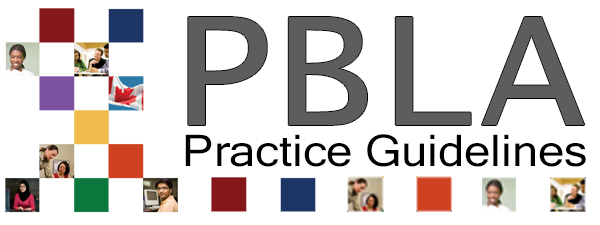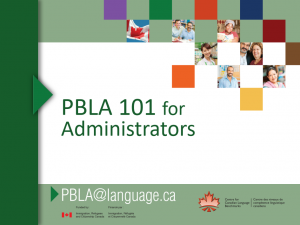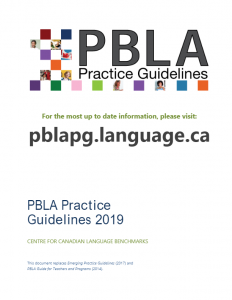PBLA Foundations
Classroom-based Assessment
Classroom-based Assessment
Assessment for learning foregrounds the professional role of teachers in assessment (Davison & Leung, 2009; Leahy & Wiliam, 2011; Black & Wiliam, 1998; Daugherty, 2011), and as such is consistent with Makosky’s (2008) and Nagy and Stewart’s (2009) calls for a teacher-led assessment protocol in Canada.
The increased emphasis on AfL strategies, along with the focus on the interrelationship of formative and summative assessment, led to further research of the advantages of classroom- based assessment, and the professional role of teachers in that assessment (Black, Harrison, Lee, Marshall & Wiliam, 2003; Davison & Leung, 2009; Gardner, Harlen, Hayward and Stobart, 2010; Leahy and Wiliam, 2011; Harlen, 2004, 2005; Klenowski & Wyatt-Smith, 2014).
Part of this discussion has focused on the dependability of classroom-based assessment. In 2004, Wynne Harlen of the University of Cambridge undertook a systematic review of 30 papers for the Evidence for Policy and Practice Information (EPPI) Centre of the University of London, England, in order to provide research evidence for the dependability of summative assessment by teachers. The study also explored the conditions that affect the reliability and validity of teachers’ summative assessments. It found that assessments by teachers had the potential to provide accurate summative information when specific conditions were met.
Additionally, in the longitudinal King’s Oxfordshire Summative Assessment Project (KOSAP), teacher educators/researchers collaborated with a group of 18 teachers over a period of two and a half years, to explore strategies that could enhance the quality of teachers’ summative assessments and to promote a positive interaction between formative and summative assessment practices (Black, Harrison, Hodgen, Marshall & Serret, 2011). Together, the two studies suggest a number of conditions for quality classroom-based assessment.
Both studies found that the task design process was key to reliable assessment. Designing the task gave teachers a deep understanding of learning goals and criteria, and this understanding was in turn key to task and assessment validity. For this reason, Harlen argues that programs should support teachers in the development of tasks and criteria, rather than merely developing standardized assessment tasks (Harlen, 2005, p. 267). The KOSAP study found that the careful implementation of tasks was key to effective assessment, including how tasks and criteria were introduced in the class, the amount of scaffolding provided, and the use of peer assessment.
Teachers in the KOSAP study specifically explored how summative assessment could be embedded in classroom work and how learner portfolios could be structured to include a range of tasks appropriate to the learning goals.
Both studies also found that the dependability of the summative results lay in a shared interpretation of assessment criteria. Both emphasized the value of moderation (sometimes called calibration) sessions in which teachers look at learner work together, as an important step in developing a shared understanding of learning goals and related assessment criteria.
To foster both task and assessment dependability, we integrate many of these measures in PBLA. Teachers develop tasks and criteria that align with CLB standards and learner-identified interests and goals, they share criteria with learners, they encourage learner self-assessment and learning reflection, and they collect a balance and range of tasks in portfolios.
Teachers are also encouraged to work collaboratively, supported by professional development resources, to establish a common understanding of assessment standards.
Classroom- or teacher-based assessment involves teachers from the beginning to the end: from planning the assessment program, to identifying and/or developing appropriate real-world assessment tasks, to making assessment judgments. It also engages learners, especially if self- assessment and peer feedback are complemented with teacher assessment and feedback.
According to Davison and Leung (2009), classroom-based assessment has several benefits in the table below.
Table 1: Advantages of Teacher-based Assessment
| Feature | Advantage |
| Scope | Teacher-based assessment extends the range and diversity of assessment collection opportunities, task types and real world contexts. |
| Authenticity | It assesses work being done within the classroom; because the teacher knows learner capabilities, assessments are more likely to be realistic. |
| Reliability | It improves reliability by having more than one assessment by a teacher who is familiar with the learner; it allows for multiple opportunities for assessor reflection. |
| Fairness | It achieves fairness by following commonly agreed processes, outcomes and standards. |
| Feedback | Learners can receive constructive feedback immediately after the assessment has finished, hence improving learning. |
| Positive Washback | Ongoing assessment encourages learners to work consistently and provides important data for evaluation of teaching and assessment practices in general. |
| Teacher and Learner Empowerment | Teachers and learners become part of the assessment process; collaboration and sharing of expertise can take place within and across schools. |
| Professional Development | It provides an opportunity for teachers to build their assessment skills and better understand the CLB standards. |
Adapted from Table 2 in Davison and Leung (2009, pp. 402-403).


